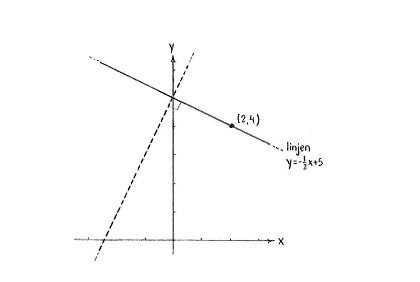Lösung 2.2:5d
Aus Online Mathematik Brückenkurs 1
K (Lösning 2.2:5d moved to Solution 2.2:5d: Robot: moved page) |
|||
| Zeile 1: | Zeile 1: | ||
| - | {{ | + | If two non-vertical lines are perpendicular to each other, their gradients |
| - | < | + | <math>k_{1}</math> |
| - | {{ | + | and |
| + | <math>k_{2}</math> | ||
| + | satisfy the relation | ||
| + | |||
| + | <math>k_{1}k_{2}=-1</math>, and from this we have that the line we are looking for must have a gradient that is given by | ||
| + | |||
| + | |||
| + | <math>k_{2}=-\frac{1}{k_{1}}=-\frac{1}{2}</math> | ||
| + | |||
| + | |||
| + | since the line | ||
| + | <math>y=2x+5</math> | ||
| + | has a gradient | ||
| + | <math>k_{1}=2</math> | ||
| + | (the coefficient in front of | ||
| + | <math>x</math> | ||
| + | ). | ||
| + | |||
| + | The line we are looking for can thus be written in the form | ||
| + | |||
| + | |||
| + | <math>y=-\frac{1}{2}x+m</math> | ||
| + | |||
| + | |||
| + | with | ||
| + | <math>m</math> | ||
| + | as an unknown constant. | ||
| + | |||
| + | Because the point | ||
| + | <math>\left( 2 \right.,\left. 4 \right)</math> | ||
| + | should lie on the line, | ||
| + | <math>\left( 2 \right.,\left. 4 \right)</math> | ||
| + | must satisfy the equation of the line, | ||
| + | |||
| + | |||
| + | <math>4=-\frac{1}{2}\centerdot 2+m</math> | ||
| + | |||
| + | |||
| + | i.e. | ||
| + | <math>m=5</math>. The equation of the line is . | ||
| + | |||
| + | |||
| + | <math>y=-\frac{1}{2}x+5</math> | ||
| + | |||
| + | |||
| + | |||
| + | |||
{{NAVCONTENT_START}} | {{NAVCONTENT_START}} | ||
<center> [[Image:2_2_5d-2(2).gif]] </center> | <center> [[Image:2_2_5d-2(2).gif]] </center> | ||
| - | {{NAVCONTENT_STOP}} | ||
| - | [[Image:2_2_5_d.jpg|center|300px]] | ||
Version vom 09:50, 18. Sep. 2008
If two non-vertical lines are perpendicular to each other, their gradients \displaystyle k_{1} and \displaystyle k_{2} satisfy the relation
\displaystyle k_{1}k_{2}=-1, and from this we have that the line we are looking for must have a gradient that is given by
\displaystyle k_{2}=-\frac{1}{k_{1}}=-\frac{1}{2}
since the line
\displaystyle y=2x+5
has a gradient
\displaystyle k_{1}=2
(the coefficient in front of
\displaystyle x
).
The line we are looking for can thus be written in the form
\displaystyle y=-\frac{1}{2}x+m
with
\displaystyle m
as an unknown constant.
Because the point \displaystyle \left( 2 \right.,\left. 4 \right) should lie on the line, \displaystyle \left( 2 \right.,\left. 4 \right) must satisfy the equation of the line,
\displaystyle 4=-\frac{1}{2}\centerdot 2+m
i.e.
\displaystyle m=5. The equation of the line is .
\displaystyle y=-\frac{1}{2}x+5

